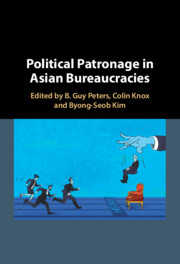Book contents
- Political Patronage in Asian Bureaucracies
- Political Patronage in Asian Bureaucracies
- Copyright page
- Contents
- Figures
- Tables
- Contributors
- Abbreviations
- 1 Patronage in Asian Political Systems
- Part I One-Party Dominated Systems
- Part II Two-Party/Multi-Party Systems
- 5 Patronage Appointment in Japanese Politics
- 6 Patronage in Mongolia
- 7 Loyalty or Expertise? The Practice of Political Patronage in Taiwan
- 8 Political Appointments in South Korea
- 9 Patronage Appointments in the Philippine Public Service
- Part III Autocracies
- Index
- References
5 - Patronage Appointment in Japanese Politics
Political Representation in a Large Bureaucracy
from Part II - Two-Party/Multi-Party Systems
Published online by Cambridge University Press: 05 October 2023
- Political Patronage in Asian Bureaucracies
- Political Patronage in Asian Bureaucracies
- Copyright page
- Contents
- Figures
- Tables
- Contributors
- Abbreviations
- 1 Patronage in Asian Political Systems
- Part I One-Party Dominated Systems
- Part II Two-Party/Multi-Party Systems
- 5 Patronage Appointment in Japanese Politics
- 6 Patronage in Mongolia
- 7 Loyalty or Expertise? The Practice of Political Patronage in Taiwan
- 8 Political Appointments in South Korea
- 9 Patronage Appointments in the Philippine Public Service
- Part III Autocracies
- Index
- References
Summary
In early prewar modernization period of Japan, party patronage was used to control the entrenched elite bureaucracy. Patronage was used to anchor the democratic representation of the national government officials who were given their own legitimacy. After Japan was defeated in World War II, Japan was institutionally fully liberalized and democratized. However, the reform of the old political regime was implemented through the Japanese bureaucracy. This fact demonstrates that the bureaucracy maintained substantial influence over the national policy-making process during post-war period. As the Liberal Democratic Party members accumulated policy-making capacities in certain economic fields, clientelism and particularism became key features of Japanese politics. But it did not particularly involve patronage appointments. It was rather connected with other “porks” such as economic benefits to the electoral consistency. As a result, from a comparative perspective, patronage practice in Japanese politics may be rather limited in its scope and depth, compared with other democracies in Asia.
- Type
- Chapter
- Information
- Political Patronage in Asian Bureaucracies , pp. 99 - 120Publisher: Cambridge University PressPrint publication year: 2023



